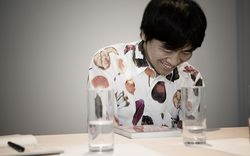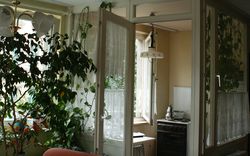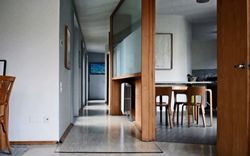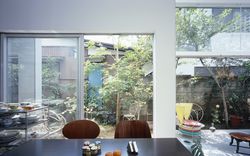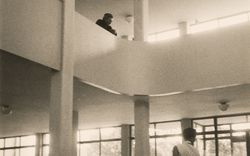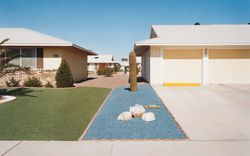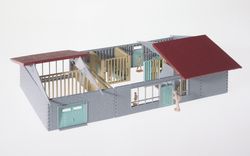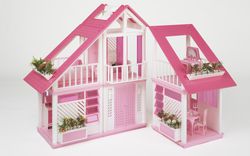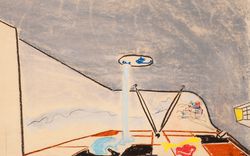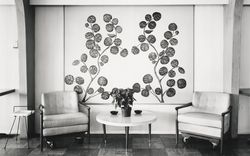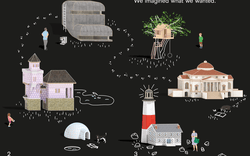A Few Notes on Plants Indoors
Text by Carrie Smith
Potted plants have been brought indoors for millennia, providing perfumes, seasonings, and medicines for the aristocracy and clergy. (There is evidence of clay pots inside ancient Chinese and Egyptian buildings, for example.1) But it was not until after the Industrial Revolution that a vast array of changes—the growth of the middle class, increased personal wealth, increased rates of literacy (especially among women), advanced building technologies (such as indoor heating and cheaper glass)—contributed to the viability and popularity of plants in interiors.2 It was only when indoor plants became commonplace that they lost their functionality and joined the set of decorative objects involved in the expression of the self within the interior.3 The design historian Penny Sparke cites the writings of Walter Benjamin to describe how the rise of modernity and modern life was accompanied by a parallel turn toward the private individual. As she writes, the modern interior became “the inside location of people’s experiences of, and negotiations with, modern life”—a place for inward reflection and awareness.4
Decorating with plants has become so commonplace that we barely register the presence of plants in our interiors today. Houseplants are found anywhere—banks, schools, magazine spreads in Elle Decor—and they are sold widely, including in flower shops, in grocery stores, and at IKEA. It is perhaps because indoor plants belong to multiple disciplines—the technical cultivation of plants falls into the discipline of horticulture, decoration with plants is in the purview of interior design, and outdoor gardens are the domain of landscape design—that they go unnoticed and have not attracted much academic study. No single discipline has claimed indoor plants for itself.
Rather than being a detriment, this ambiguity allows indoor plants to operate in ways that are not subject to the functions, expectations, and disciplinary boundaries that constrain other objects in the interior. It is also worth noting that plants can be used to design, but are not themselves designed objects, in the sense that we do not have complete control over the way plants look, or over their natural processes. (A flower can fall off; a leaf can be consumed by mites.) There are almost no rules for who can sell plants, who can buy plants, what they can be used for, and where they can be located. For these reasons, plants encourage fluid and novel ways to participate in the designed environment.
Decoration
Plants and flowers have a long history of being represented in the interior as ornamentation on column capitals, arches, wall coverings, and other architectural elements. Vitruvius’s myth of the origin of the Corinthian capital firmly situates its ornamentation as a representation of actual plants. He explains the capital’s genesis as follows: the artist Callimachus spots acanthus leaves growing through a woven basket set upon a grave, is delighted by the tableau, and replicates it in a column.1 The acanthus leaves were chosen because their form and shape were attractive and therefore potentially decorative.
When plants moved indoors, opportunities arose for them to become part of this same decorative palette. For example, many Victorian indoor gardening handbooks encouraged the practice of growing ivy around an arch to mimic carved wooden archways from the Middle Ages. The live ivy recreates the effects of the wood-carved representation of ivy, and in the process, becomes decorative itself.
As plants filled decorative roles within the interior, designs began to blur the distinction between ornamentation—the representation of plants—and actual plants. Examples can be found of plants acting like sculptural elements (in the way a potted plant might become a three-dimensional extension of greenery in a painting) or mimicking the functions and forms of certain decorative elements (such as curtains). This creates a fantastic obfuscation, further exploiting the plant’s disciplinary ambiguity between horticulture and decoration. It becomes difficult to define where the decoration starts and ends; this blurring allows for an expansion of the range of objects for self-expression within the interior, creating new modes and media for how we convey information about ourselves and how we want to be perceived.
-
Vitruvius, The Ten Books on Architecture, trans. Morris Hickey Morgan (Cambridge: Harvard University Press, 1914), 104–106. ↩
Spatial mediation
As early as 1608, when Hugh Plat wrote Floraes Paradise, one of the first English-language volumes on gardening to contain a chapter on indoor plants, it was understood—if only empirically—that indoor plants needed something from the outside. Plat writes, “You must often set open your casements, especially in the day time, which would be many in number; because flowers delight and prosper in the open air.”1 As plants were brought inside, they maintained a close physical proximity to the outdoors. Although this seems to be an obvious and simple fact, it creates a rich and nuanced relationship between the plant and openings in the opaque surfaces of buildings. It locates plants within the interior, but with a strong and nonnegotiable relationship to the outside.
In the centuries since Floraes Paradise was written, plants have been used in numerous ways to exploit this ambiguity and to create varying readings of the distinction between inside and outside. One strategy enlists plants to enlarge, expand, and blur the threshold between the two. Windows bulge out from their typical planes, thrusting plants placed inside out. Other designs invert our expectations of the window as a gesture to the outdoors from the inside, and instead frame indoor plants from the outside, adding to the streetscape. Furthermore, in the context of exhibitions, theatre sets, or other spaces where an interior is built within a shell, indoor plants can be used as a way to designate a space as indoors. In the case of the Deutsche Bauausstellung (German Building Exposition) in Berlin in 1931, a model facade took the shape of an International-Style residence. To demarcate the interior of the residence from its hangar-like exterior, indoor-variety plants (including the ubiquitous rubber plant) press up against the glass while a potted, topiary-style plant signals the “outdoors.” Here, the relationship between the plant and the exterior is used to clarify a situation in which the distinction between interior and exterior is ambiguous.
In a more contemporary example, Junya Ishigami uses plants in his designs and disregards common disciplinary constraints; his work moves fluidly between furniture design, architecture, and landscape design. His project “Tables for a Restaurant” combines landscape design and furniture design in a fantastic microcosm: a series of giant tables function as sites where potted plants inhabit a miniature landscape, create spatial divisions, and set moods. Ishigami uses indoor plants in the same ways that landscape designers use plants outside.
These cases exploit the spatial ambiguity of the indoor plant to encourage new and at times surprising readings of the relationship between the interior and the exterior. The indoor plants create situations that defy our expectations of the roles of the interior and the exterior and, in doing so, encourage us to rethink the distinction between these two spatial categories.
-
Hugh Plat, Floraes Paradise (London: H. Lownes for William Leake, 1608), 31. ↩
Status symbols
From early on, indoor plants have been understood as objects capable of conveying information about social status, indicating wealth, taste, and connection to the environment. In the 1800s, plants were expensive and required an interior environment that could only be achieved in houses with certain technologies and luxuries. Plants also required quite a bit of care and attention in order to survive in this less-than-ideal environment.1 They quickly became entangled in the spectacle of wealth and status display—what Thorstein Veblen termed conspicuous consumption.2 Indoor plants were fully objectified; housewives consulted guidebooks and periodicals to keep up with the most fashionable varieties.
As the Victorian era came to a close, indoor plants had become commonplace and inexpensive;3 consumer culture had grown to include more veiled symbols of social status. Keeping in step with these changes, our use of indoor plants evolved to signify more nuanced concepts of lifestyle. Because houseplants have a connection to nature, indoor plants came to signify health- and eco-consciousness—concepts that have been shown to be closely associated with certain education levels, political leanings, and social standing.4 Status is no longer conveyed through the conspicuous display of time and money invested in the plants; rather, indoor plants are now able to symbolize status indirectly, through indicators of lifestyle.
This conflation of living object and status symbol allows indoor plants to be used in ways that were unthinkable a century ago. For example, plants are used in advertisements to sell eco-friendly washing machines, and hydroponic window garden systems are branded as facilitating healthy lifestyles. These design opportunities are possible because the indoor plant can exist simultaneously as a decorative object and as a living part of nature. A new definition is added to the role of indoor plants, and the ways they can be used in the interior is expanded.
-
Tovah Martin, Once Upon a Windowsill: A History of Indoor Plants (Portland, Oregon: Timber Press, 1988), 19–21. ↩
-
Thorstein Veblen, The Theory of the Leisure Class; an Economic Study of Institutions (New York: The MacMillan Company, 1912), 68. ↩
-
Horwood, Potted History, 92–94. ↩
-
Frederick H. Buttel and William L. Flinn, “The Politics of Environmental Concern: The Impacts of Party Identification and Political Ideology on Environmental Attitudes,” Environment and Behavior 10, no. 1 (1978): 17–36. ↩
Carrie Smith was CCA Emerging Curator in 2012–2013.
